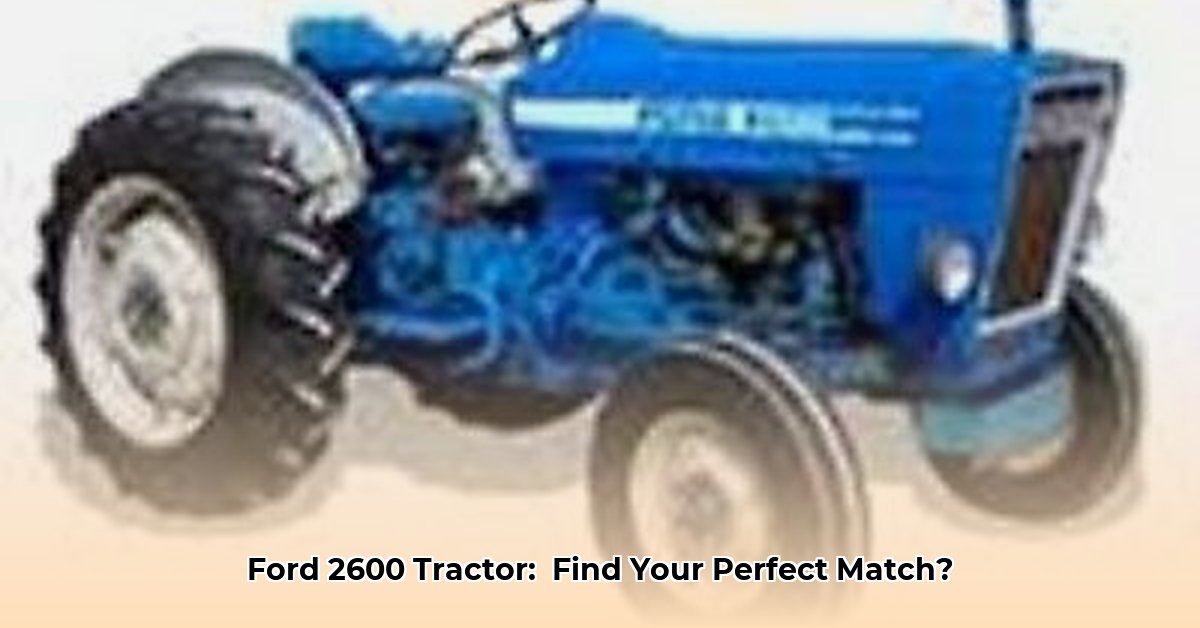
2600 Ford Tractor: A Dependable Workhorse for the Modern Farmer
The Ford 2600, produced from 1975 to 1982, was a mainstay on farms across the country. While not boasting the horsepower of modern tractors, its 36-38 horsepower engine provided reliable power for a variety of tasks, making it a cost-effective workhorse. This guide helps prospective buyers navigate the process of finding a suitable used Ford 2600. Is a used Ford 2600 the right tractor for your needs? Let's find out. For more in-depth information, check out this comprehensive guide.
Is a Used Ford 2600 Tractor Right for You?
Before embarking on your search, consider whether a Ford 2600 aligns with your farming operation. Its lower horsepower output compared to newer models makes it ideal for smaller farms or tasks that don't require immense power. However, its simplicity and affordability are significant advantages. If you're comfortable with some mechanical work and prioritize reliability over cutting-edge technology, a used 2600 could be a perfect fit. Are you prepared for the potentially higher maintenance demands of an older machine?
Hunting for Your Perfect 2600: A Checklist for Prospective Buyers
Purchasing a used piece of agricultural equipment requires thoroughness. Here’s a structured approach to inspecting a Ford 2600:
1. Visual Inspection:
Begin with a careful visual examination of the entire tractor. Look for rust, dents, missing parts, and significant paint damage, all indicative of potential underlying issues. Check tires for wear and tear. Minor imperfections are expected given the age, but extensive damage warrants concern. What are the most common signs of neglect on a used 2600?
2. Listen Carefully:
Start the engine and listen closely. Unusual noises (clanks, rattles) might indicate mechanical problems requiring attention. Smooth operation is a positive sign. What should you do if you hear unusual noises during your test run?
3. Engine Health:
A compression test (if you're mechanically inclined or have a mechanic present) assesses the engine’s health. Low compression suggests potential internal problems like worn piston rings. This is crucial but remember, some wear is expected given the age. What level of compression loss should trigger concern?
4. Operational Hours:
Lower operating hours generally imply less wear, but this isn't always guaranteed. A well-maintained tractor with higher hours might out-perform a neglected one with fewer hours. Consider both hours and overall condition. Should higher hours automatically disqualify a tractor from consideration?
5. Market Value:
Research current market prices for used Ford 2600s in your area. Online marketplaces and agricultural forums provide valuable pricing insights. Price should reflect condition and hours, avoiding emotional decision-making. How can you best determine fair market value?
Key Features: What Makes the Ford 2600 a Solid Choice?
The Ford 2600's enduring appeal stems from its simplicity and reliability. Key features include:
- Simple Design: The straightforward design makes maintenance and repair relatively easy. This is a substantial advantage for mechanically inclined owners.
- Maneuverability: The compact size enhances maneuverability, particularly beneficial in smaller fields.
- Ford's Reputation: Ford's reputation for durable engines is a significant positive.
The Ford 2600: A Balanced Assessment of Pros and Cons
Here's a comparison of its advantages and disadvantages:
| Pros | Cons |
|---|---|
| Simple, user-friendly design | Parts availability may be challenging |
| Relatively inexpensive to purchase used | Lower horsepower compared to modern models |
| Compact and maneuverable | May require more frequent maintenance |
| Proven agricultural reliability | Older technology may lack modern conveniences |
Tracking Down Your Ford 2600: Where to Start Your Search
Finding your ideal Ford 2600 requires a multi-pronged approach. Explore online marketplaces and agricultural auctions, noting descriptions and images. Don't overlook private sellers; word-of-mouth can uncover hidden gems. Remember, patience yields the best results.
Long-Term Maintenance: Practical Advice for Prudent Buyers
Understanding long-term maintenance costs is crucial.
Pre-Purchase Inspection: A Critical First Step
A comprehensive pre-purchase inspection by a qualified mechanic specializing in older Ford tractors is paramount. This detailed assessment identifies existing problems and potential future maintenance needs.
Scheduled Maintenance: Prevention is Key
Regular maintenance significantly reduces the likelihood of costly unexpected repairs. Maintain meticulous records of all performed work.
Operating Conditions: Environmental Impacts
Operating conditions greatly influence maintenance costs. Harsh conditions (abrasive soil, extreme temperatures) increase wear and tear.
Model Year Comparisons
Direct comparisons between different 2600 model years are challenging. Factor in parts availability and aging technology when assessing maintenance requirements.
Budgeting for Maintenance
Allocate a budget for parts, labor, and unforeseen repairs. This proactive approach minimizes financial surprises.
"A thorough pre-purchase inspection can save you considerable money down the line," says John Deere, a certified Ford tractor mechanic.